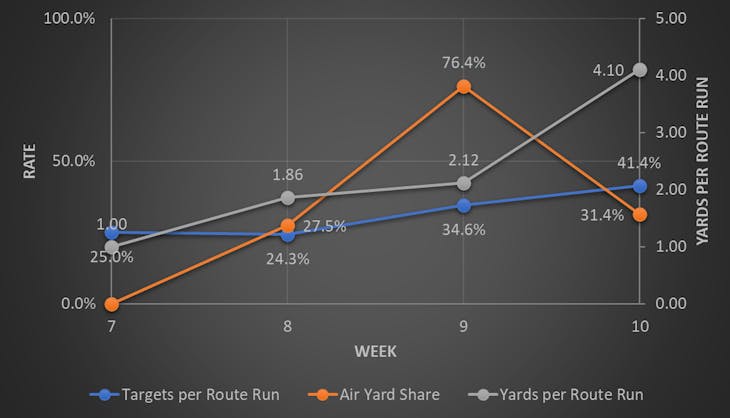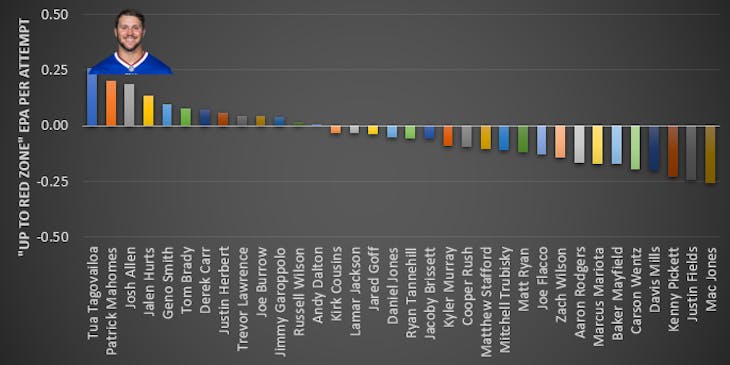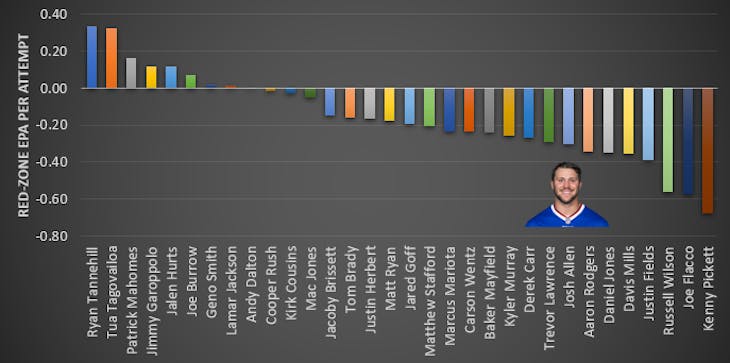What a week of action. Two games went into overtime. A pair of backup quarterbacks started for their respective teams. We had Germans singing American songs during a football game, and, of course, we got to watch the “fighting Jeff Saturdays” get the W in the afternoon. I’m glossing over many other highlights, but this happens every week. We miss the nuance in the excitement. So, as always, I’ve got three takeaways from Week 10 and how to approach them as a fantasy manager.
Quarterback: Josh Allen, Bills
Week 10 Results: (Projected) 21.0, (Actual) 19.6
Old Takes Exposed could have added me to the list of people assuming the game was over after the fourth-down stop with 50 seconds left. Buffalo couldn’t possibly lose another game with less than a minute left on the clock. But chaos reigns supreme in the NFL. Well, specifically, it resides in Josh Allen’s hands.
I want to blame Allen’s UCL injury. Or, I’m assuming Bills fans do, but his turnovers are symptomatic of another issue. And after a closer look, I have some concerns about the Bills’ passing game.
Advice Moving Forward:
Consider Allen as a top-6 instead of a top-3 option. His dip in efficiency makes him volatile each week, but his rushing should keep him in contention for QB1 overall.
Allen is still top 12 in every passing metric from EPA per play to deep-ball rate. But fantasy managers took him as the first quarterback off the board. His cost comes with expectations. So we don’t need top-12 numbers. We need top-1 results in every facet. And over the last few weeks, Allen’s taken a step back.
His red-zone turnovers were my first clue. Interceptions are fluky by nature. But three consecutive weeks with a giveaway deep in an opponent’s territory is worth a deep dive. Surprisingly, he’s been on this trend since Week 5.

Allen’s had a negative EPA per attempt for the past six weeks. His on-target passing rate on throws inside the 20-yard line is the same as Kenny Pickett’s (50.0%). But I’m not ready to panic. It’s not like he’s completely forgotten how to throw the ball. It’s just in one specific area of the field.
Since Allen can throw a touchdown pass from his end zone, I pulled every attempt up to the opponent’s 20. And in this area, Allen is still top 3 in EPA per attempt among all starting quarterbacks. He’s fourth in passing yards and tied for first in touchdowns. By most metrics, he’s still the quarterback we drafted back in August across 80.0% of the field. And then we get to the red zone.
Sure, I’m splitting hairs. But opportunity cost matters even in November. Patrick Mahomes II, Jalen Hurts, and Lamar Jackson are all still in the top 10 for red-zone efficiency. And yet, we find Allen next to Trevor Lawrence and Aaron Rodgers. I’d blame his pass-catchers, but they haven’t had a red-zone drop since Week 5. Luckily, Allen’s mobility covers for his mistakes.
The UCL injury limited his designed rushing attempts to a season-low on Sunday. Regardless, he still racked up 84 yards on scrambles. His groundwork will keep him in the top-6 discussion each week. But the dip in red-zone efficiency will limit his ceiling. We’ll need to adjust our expectations of Allen’s potential output until it improves.
Running Back: Rachaad White, Buccaneers
Week 10 Results: (Projected) 8.8, (Actual) 10.5
I started seeing chatter about Rachaad White starting for Tampa Bay on Sunday morning. As fans, I don’t think we bullied the Buccaneers into making a change. Nor do I think the coaches “read the tweets,” as the kids say. But White took the team’s first and last carry in Week 10. They’re also on bye this week. So, of course, there’ll be plenty of “well-reasoned” debate on social as to who should see more work. Let’s dig into his first NFL start, but White should be on your roster if you can get him, regardless.
Advice Moving Forward
White is a high-priority waiver target, if available. He’s a low-end RB2/high-end RB3 assuming Fournette is available for Week 12.
First off, for those who didn’t catch the 9:30 AM EST kickoff, Leonard Fournette was injured midway through the third quarter. So, his absence skews White’s 64.0% snap share. However, the rookie played a much larger role even when both were available.

The boxscores will tell you White had a 42.1% rushing share in Week 9 and a 42.9% share against Baltimore. So, on the surface, his workload doesn’t indicate a shift. But against the Rams, he didn’t see his first carry until the second quarter. Half of his attempts came in the fourth quarter of their blow-out loss to Carolina. Week 10 was different.
It’s not just White getting the ceremonial start (Fournette got the second carry on the next series) but his inclusion in high-leverage situations. On the season, the veteran had 65.8% of the carries across all three scenarios (third down, short yardage, and two minute). It was a near-even split on Sunday. Plus, we all saw what he did on the field. And the stats align with the eye test.
|
Metric |
White |
Fournette |
|
Missed Tackles |
4 |
1 |
|
Yards After Contact per Attempt |
2.64 |
2.57 |
|
Explosive Runs |
6 |
1 |
|
Success Rate |
36.4% |
42.8% |
For transparency, I couldn’t break down the missed tackles and yards after contact by quarter. So we’re looking at the complete game totals. White had three explosive runs in the fourth quarter, but he was already outpacing Fournette. Plus, before Week 10, White was the more efficient runner of the two (0.20 vs. -0.03 EPA per attempt). A running-back tandem would be a positive change for White and the Buccaneers’ offense as a whole.
Tampa is running more on first downs and third-and-short situations than last year. However, the Buccaneers are 26th or worse in rushing EPA in both scenarios. They needed to make a change, and White could deliver. With Fournette expected back after the bye, White is a low-end RB2 against two teams in the bottom half in rushing efficiency allowed (at CLE and vs. NO). White is a priority target on the waiver wire or worth trading for as a bench stash for depth.
Wide Receiver: Amon-Ra St. Brown, Lions
Week 10 Results: (Projected) 16.1, (Actual) 22.1
Finally, it happened. We got the big game from Amon-Ra St. Brown. But honestly, I was concerned about St. Brown after he returned from injury. His snap rates were back up above 75.0%. He led the team in targets in the two games leading into Sunday. But the volume wasn’t translating to fantasy success. He didn’t crack 75 yards in either game. However, his underlying metrics were telling us a different story. And as a result, Week 11 shouldn’t have been as much of a surprise.
Advice Moving Forward:
St. Brown is firmly back in the top-12 discussion for wide receivers. Any trade discussions should involve high-end running backs or package deals with top quarterbacks or tight ends.
Before missing Week 4, St. Brown was top 10 in almost every receiving metric. His 30.8% target share was greater than Stefon Diggs’s and JaMarr Chase’s. Cooper Kupp had a lesser targets per route run rate. St. Brown was challenging every elite wide receiver each week until he was injured.
After he returned in Week 7, I assumed he’d need time to get back in sync with Jared Goff. No one on the Lions can replace St. Brown, but his diverse route patterns require timing. Regardless, the sophomore receiver picked up where he left off and exceeded his early-season output.

St. Brown’s largest issue was his air yard share. D.J. Chark commanded more intermediate and deep targets leaving St. Brown with more work underneath. We didn’t mind as fantasy managers. He was still third in points per game in PPR formats. However, he’s at a 38.1% share over the last three weeks. It was 20.8% through Week 3.
His targets and efficiency steadily increased heading into Week 10, hence the lack of surprise. Across Weeks 8 and 9, St. Brown was fifth in TPRR and 14th in YPRR amongst all wide receivers. I’m not expecting a repeat of 4.10 YPRR. However, he was ranked top 5 in yards after the catch early in the season and second after Week 10.
Chark’s return, or any involvement from Jameson Williams, may scale back St. Brown’s air yards. But his volume remains unquestioned. Any trade negotiations should value him similarly to mid to low-end top-12 running backs (e.g., Dalvin Cook) or top players at the “onesie” positions (e.g., Patrick Mahomes II, Travis Kelce).


